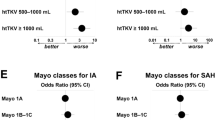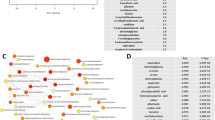Abstract
Background
The phase 3 Tolvaptan Efficacy and Safety in Management of Autosomal Dominant Polycystic Kidney Disease and Its Outcomes (TEMPO 3:4) clinical trial demonstrated the beneficial effect of tolvaptan on kidney growth and function in subjects aged 18–50 years over a 3-year period. However, it did not specifically assess the use of tolvaptan in adolescents and young adults (AYAs) with ADPKD.
Methods
A post hoc analysis of the TEMPO 3:4 trials was performed for patients aged 18–24 years. The primary outcome was the annual rate of change in total kidney volume (TKV). The secondary outcome was to evaluate long-term safety of tolvaptan using Hy’s law of hepatotoxicity.
Results
A total of 51 patients in the 18–24 age group were analyzed (tolvaptan: 29, placebo: 22). The tolvaptan group had a lower mean percentage of TKV growth per year compared to the placebo group (3.9% vs. 6.5%, P = 0.0491). For secondary outcomes, 63 patients in the AYA subgroup were evaluated. In both the AYA and adult groups, none of the patients met the criteria for Hy’s law of hepatotoxicity.
Conclusions
This post hoc analysis suggests that tolvaptan, with appropriate patient selection and management, can provide effective and acceptably safe treatment in AYAs with ADPKD.
Impact
-
Tolvaptan slows the increase in total kidney volume in patients aged 18–24 years with ADPKD.
-
Tolvaptan posed no risk of potential liver injury measured via Hy’s law of hepatotoxicity in the AYA stratum.
-
This study suggests that tolvaptan has beneficial outcomes in AYAs.
-
This post hoc analysis suggests the need for additional studies with a larger pediatric patient population.
-
The impact is significant as tolvaptan had not been specifically examined in the AYA patient population previously.
Similar content being viewed by others
Log in or create a free account to read this content
Gain free access to this article, as well as selected content from this journal and more on nature.com
or
References
Chebib, F. T. & Torres, V. E. Autosomal dominant polycystic kidney disease: core curriculum 2016. Am. J. Kidney Dis. 67, 792–810 (2016).
Torres, V. E. et al. Effective treatment of an orthologous model of autosomal dominant polycystic kidney disease. Nat. Med. 10, 363–364 (2004).
Belibi, F. A. et al. Cyclic AMP promotes growth and secretion in human polycystic kidney epithelial cells. Kidney Int. 66, 964–973 (2004).
Dell, K. M. The spectrum of polycystic kidney disease in children. Adv. Chronic Kidney Dis. 18, 339–347 (2011).
Miskulin, D. C. et al. Health-related quality of life in patients with autosomal dominant polycystic kidney disease and CKD stages 1-4: a cross-sectional study. Am. J. Kidney Dis. 63, 214–226 (2014).
Blanchette, C. et al. Burden of autosomal dominant polycystic kidney disease: systematic literature review. Am. J. Pharm. Benefits 7, e27–e36 (2015).
Ong, A. C. et al. Autosomal dominant polycystic kidney disease: the changing face of clinical management. Lancet 385, 1993–2002 (2015).
Chapman, A. B. et al. Kidney volume and functional outcomes in autosomal dominant polycystic kidney disease. Clin. J. Am. Soc. Nephrol. 7, 479–486 (2012).
Perrone, R. D. et al. Total kidney volume is a prognostic biomarker of renal function decline and progression to end-stage renal disease in patients with autosomal dominant polycystic kidney disease. Kidney Int. Rep. 2, 442–450 (2017); erratum 3, 1015 (2018).
Torres, V. E. Vasopressin antagonists in polycystic kidney disease. Semin. Nephrol. 28, 306–317 (2008).
US Food and Drug Administration. Drug approval package: Jynarque (tolvaptan). https://www.accessdata.fda.gov/drugsatfda_docs/nda/2018/204441Orig1s000TOC.cfm (2018).
Otsuka America Pharmaceutical, Inc. JYNARQUE® (tolvaptan) Package Insert (Otsuka America Pharmaceutical, Inc., Rockville, MD, 2018).
Torres, V. E. et al. Tolvaptan in patients with autosomal dominant polycystic kidney disease. N. Engl. J. Med. 367, 2407–2418 (2012).
Torres, V. E. et al. Tolvaptan in later-stage autosomal dominant polycystic kidney disease. N. Engl. J. Med. 377, 1930–1942 (2017).
Torres, V. E. et al. Rationale and design of the TEMPO (Tolvaptan Efficacy and Safety in Management of Autosomal Dominant Polycystic Kidney Disease and Its Outcomes) 3–4 study. Am. J. Kidney Dis. 57, 692–699 (2011).
Hauptman, P. J. et al. Comparison of two doses and dosing regimens of tolvaptan in congestive heart failure. J. Cardiovasc. Pharmacol. 46, 609–614 (2005).
Shoaf, S. E. et al. In vitro P-glycoprotein interactions and steady-state pharmacokinetic interactions between tolvaptan and digoxin in healthy subjects. J. Clin. Pharmacol. 51, 761–769 (2011).
Shoaf, S. E., Bricmont, P. & Mallikaarjun, S. Effects of CYP3A4 inhibition and induction on the pharmacokinetics and pharmacodynamics of tolvaptan, a non-peptide AVP antagonist in healthy subjects. Br. J. Clin. Pharmacol. 73, 579–587 (2012).
Cornec-Le Gall, E. et al. The PROPKD score: a new algorithm to predict renal survival in autosomal dominant polycystic kidney disease. J. Am. Soc. Nephrol. 27, 942–951 (2016).
Bhutani, H. et al. A comparison of ultrasound and magnetic resonance imaging shows that kidney length predicts chronic kidney disease in autosomal dominant polycystic kidney disease. Kidney Int. 88, 146–151 (2015).
US Food and Drug Administration. Qualification of biomarker—total kidney volume in studies for treatment of autosomal dominant polycystic kidney disease. https://www.fda.gov/downloads/Drugs/Guidances/UCM458483.pdf2015 (2015).
Irazabal, M. V. et al. Imaging classification of autosomal dominant polycystic kidney disease: a simple model for selecting patients for clinical trials. J. Am. Soc. Nephrol. 26, 160–172 (2015).
Helal, I. et al. Serum uric acid, kidney volume and progression in autosomal-dominant polycystic kidney disease. Nephrol. Dial. Transplant. 28, 380–385 (2013).
Nicolau, C. et al. Abdominal sonographic study of autosomal dominant polycystic kidney disease. J. Clin. Ultrasound 28, 277–282 (2002).
Bergmann, C. ARPKD and early manifestations of ADPKD: the original polycystic kidney disease and phenocopies. Pediatr. Nephrol. 30, 15–30 (2014).
Magistroni, R., Corsi, C., Martí, T. & Torra, R. A review of the imaging techniques for measuring kidney and cyst volume in establishing autosomal dominant polycystic kidney disease progression. Am. J. Nephrol. 48, 67–78 (2018).
Watkins, P. B. et al. Clinical pattern of tolvaptan-associated liver injury in subjects with autosomal dominant polycystic kidney disease: analysis of clinical trials database. Drug Saf. 38, 1103–1113 (2015).
Devuyst, O. et al. Urine osmolality, response to tolvaptan, and outcome in autosomal dominant polycystic kidney disease: results from the TEMPO 3:4 trial. J. Am. Soc. Nephrol. 28, 1592–1602 (2017).
Schaefer, F. et al. Tolvaptan use in children and adolescents with autosomal dominant polycystic kidney disease: rationale and design of a two-part, randomized, double-blind, placebo-controlled trial. Eur. J. Pediatr. 178, 1013–1021 (2019).
Acknowledgements
The authors thank Otsuka Pharmaceutical Development and Commercialization, Inc. for providing the data to support this publication.
Author information
Authors and Affiliations
Contributions
R.R., M.E.D., and T.K. contributed to the conception and design of this study. R.R., R.C., and T.K. were involved in the data analysis and interpretation of the data. R.R., R.C., and M.E.D. drafted the article and revised it critically for important intellectual content. All authors have approved the final version of this manuscript.
Corresponding author
Ethics declarations
Competing interests
The authors declare no competing interests.
Patient consent
Informed consent was obtained from all patients, and this study was approved by the institutional IRB.
Additional information
Publisher’s note Springer Nature remains neutral with regard to jurisdictional claims in published maps and institutional affiliations.
Supplementary information
Rights and permissions
About this article
Cite this article
Raina, R., Chakraborty, R., DeCoy, M.E. et al. Autosomal-dominant polycystic kidney disease: tolvaptan use in adolescents and young adults with rapid progression. Pediatr Res 89, 894–899 (2021). https://doi.org/10.1038/s41390-020-0942-2
Received:
Revised:
Accepted:
Published:
Issue date:
DOI: https://doi.org/10.1038/s41390-020-0942-2
This article is cited by
-
Characteristics of patients with autosomal polycystic kidney disease reaching kidney failure by age 40
Pediatric Nephrology (2025)
-
Efficacy and safety of tolvaptan versus placebo in the treatment of patients with autosomal dominant polycystic kidney disease: a meta-analysis
International Urology and Nephrology (2022)
-
The wind of change in the management of autosomal dominant polycystic kidney disease in childhood
Pediatric Nephrology (2022)
-
Predictors of progression in autosomal dominant and autosomal recessive polycystic kidney disease
Pediatric Nephrology (2021)



